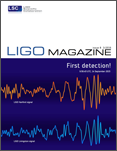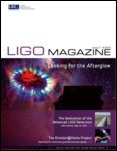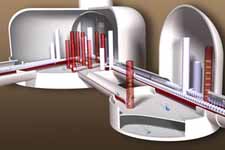Welcome to gwoptics.org! These pages provide information and software related to gravitational wave detection, with a special focus on optics research. This page also hosts outreach material of the Gravitational Wave Group Birmingham, UK, supporting the efforts by GEO 600 and the LIGO Scientific Collaboration.
30.06.2021 - Einstein Telescope enters the ESFRI Roadmap
|
Today the European Strategy Forum on Research Infrastructures (ESFRI) has announced that the Einstein Telescope will be included in its 2021 roadmap for large European infrastructures. This is an important acknowledgment of the ET project on an international and governmental level after many years of work to design the observatory, develop the science case and form the supporting scientific collaboration. |

|
24.06.2021 - Special issue on software for gravitational waves
|
A new special issue on Software that Contributed to Gravitational Wave Discovery has now been published in SoftwareX. The issue combines several articles that describe a wide range of software tools which provided significant contributions towards the first detection of gravitational waves, for example, in support of the development of the instruments, the detector operation or the analysis of the detector data. The special issue includes our article Pykat: Python package for modelling precision optical interferometers with the most up-to-date description of Finesse and Pykat. |

|
29.04.2021 - Finesse 3.0a1, first alpha release
|
In late 2017 we started the development of Finesse 3, a re-implementation of Finesse in Python, with the idea to provide a modern and clean code base that makes further developing and extending the software simpler, especially for external contributors. After four years, with a small team of core contributors, we have come a long way: the source code and documentation are growing quickly, and we are excited to test-drive this new version. Today we reached our first major milestone, the first release of an alpha version: Finesse 3.0a1. (Note that this version is not yet meant for general use, for that we recommend Finesse 2 instead.) |
|
26.04.2021 - Einstein Telescope, new impressions
|
As part of the preparations for our ESFRI application of the Einstein Telescope, we not only prepared a number of new documents, including an updated design, but Marco Kraan (Nikhef) also produced new artists impressions of the ET infrastructure, as a video and several still images. |
|
26.02.2021 - Interferometer simulation logbooks
|
Already last year we established a new website to host logbooks for interferometer simulations: https://logbooks.ifosim.org/. Logbooks are a common tool for recording progress in collaborative research projects, in particular for large hardware projects such as gravitational wave detectors. Logbooks record and preserve who did what when and thus over time create a searchable archive of expert knowledge. We adopted the same format here with the aim of generating a long term archive of interferometer models and simulations. |

|
01.01.2021 - Site Redesign
|
gwoptics.org! has now been online for over a decade! With the help of a previous student of mine, Aaron Jones, the site has been updated for another decade of use! |

|































